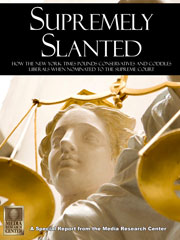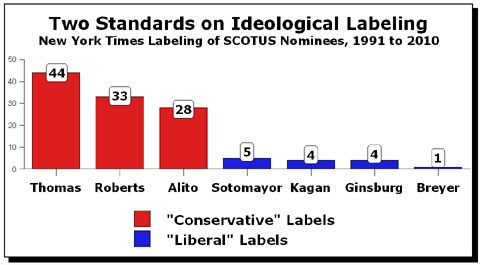Supremely Slanted
Table of Contents:
Introduction
 The story goes that when William O. Douglas, President Franklin Rooosevelt's close friend and nominee to the Supreme Court, grew tired of waiting outside the Senate Judiciary Committee room, he sent a note inside asking if the panel had any questions for him. They had none, and he was swiftly confirmed.
The story goes that when William O. Douglas, President Franklin Rooosevelt's close friend and nominee to the Supreme Court, grew tired of waiting outside the Senate Judiciary Committee room, he sent a note inside asking if the panel had any questions for him. They had none, and he was swiftly confirmed.
As liberal Justice Elena Kagan takes her place on the Supreme Court, she could thank The New York Times for making her confirmation process smoother. Ever since Ronald Reagan nominated Robert Bork and he was rejected by the Senate in 1987 for his views and not his character or qualifications, confirmation battles for liberals have become less like judicial seminars and more like political campaigns. Nominees from both parties are coached to avoid controversy, making the hearings less a hashing out of constitutional philosophies and more stylized theatre, with the parties nurturing their respective bases.
For almost 20 years, in this new era of activist groups and activist reporters, the New York Times has covered Supreme Court fights with a heavy finger on the scales of justice, tipping the balance. They have painted conservatives as highly controversial and dangerously ideological, while liberal nominees were presented as “brilliant” moderates who were only newsworthy in that they were often laudably “historic” choices, or, in Kagan’s case, she was not only “brilliant,” but “very funny, warm and witty.”
From the Times perspective, the last two decades have shown timid Democrats hesitant to nominate strong liberal, instead choosing “moderates” like Ruth Bader Ginsburg and Elena Kagan instead. By contrast, Republicans shamelessly nominate fierce conservatives, pushing the court still further to the right, encapsulated by this excerpt from an online chat by retired Supreme Court reporter Linda Greenhouse participated from July 14, 2008:
"[Supreme Court] nominations get in trouble when the President tries to use them to push beyond the boundaries of the existing political consensus. That was the Bork nomination problem. It was also the first Bush administration’s problem with the Clarence Thomas nomination -- which of course succeeded, unlike the Bork nomination, but succeeded only barely and after a rough fight. By contrast, President Clinton played to the center, not the left, in selecting Ruth Bader Ginsburg and Stephen G. Breyer.”
This study follows the arc of coverage of the last seven Supreme Court justices, starting with Clarence Thomas and ending with Elena Kagan. It follows the reporting from the initial speculation about the pick, through the nomination by the president, through the confirmation hearings before the Senate Judiciary Committee up to the nominee's eventual confirmation by the full Senate.
Times Watch's study includes every New York Times news story devoted to the nomination under review, starting with the official White House announcement and ending with the Senate vote confirming the nominee to the Supreme Court, omitting brief articles on procedural matters like hearing schedules. Brief mentions in unrelated articles were also skipped.
Columns and editorials were omitted as well, though these clearly favored Democratic nominees and disfavored Republicans.
The Times editorial page advised against the confirmation of Clarence Thomas in general terms on September 22, 1991, saying “If the Thomas nomination is to be judged on the merits, it fails.” The paper specifically editorialized for the rejection of Samuel Alito with a January 26, 2006 editorial calling the prospect of Alito becoming a justice “frightening,” as well as John Roberts, in a September 18, 2005 editorial headlined “Too Much of a Mystery.” By contrast, the Times editorialized for the confirmation of Ginsburg, Sotomayor, and Kagan. Democrat nominee Breyer was a surprise exception, as the Times recommended his rejection, although that was based on conflict of interest grounds, not his judicial philosophy, which the editorial page described as moderate.
The verdict from Times Watch research was clear: The Times covers court fights with a sharp liberal slant.
Pinning an ideological label onto a jurist is an easy shorthand to portray them as out of the mainstream. The Times demonstrated a 10-1 disparity in labeling “conservative” justices nominated by Republicans (Thomas, Roberts, Alito) compared to “liberal” ones nominated by Democrats (Ginsburg, Breyer, Sotomayor, Kagan). In all, the three Republican-nominated justices were labeled “conservative” 105 times (an average of 35 labels per nominee), while the four Democrat-nominated justices were labeled liberal on just 14 occasions (3.5 labels per nominee).

Republican nominees also received far more coverage. Clarence Thomas was the subject of 81 stories through his initial hearings, not even including the wall-to-wall coverage after law professor Anita Hill made her sexual harassment allegations. John Roberts was the subject of 107 stories, Samuel Alito 92.
Yet the 1993 battle over Ruth Bader Ginsburg was featured in a flimsy 22 Times stories, while Clinton's other pick Stephen Breyer was dealt with in a mere 20 stories in 1994. Obama nominee Sonia Sotomayor was a partial exception to the rule with 85 stories, but many of those keyed on the fact Sotomayor was a hometown pick and contained more NYC self-congratulation than legal analysis. Despite an aggressive push by the G.O.P., Elena Kagan failed to excite much interest, as she featured in only 43 stories.
Even taking into account that fewer stories for Democratic nominees should on average result in fewer ideological labels, the disparity was still sharp. While Democratic nominees were labeled liberal an average of once every 12 stories, Republican nominees were tagged conservative once every 2.66 stories. For instance, while Clarence Thomas was tagged conservative at an average rate of roughly once in every two stories (44 labels out of 81 stories), Sonia Sotomayor received a liberal label just once in every 17 stories (5 labels out of 85 stories).
Below are the findings for each justice.


